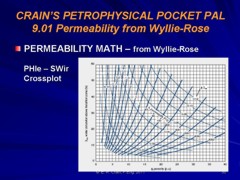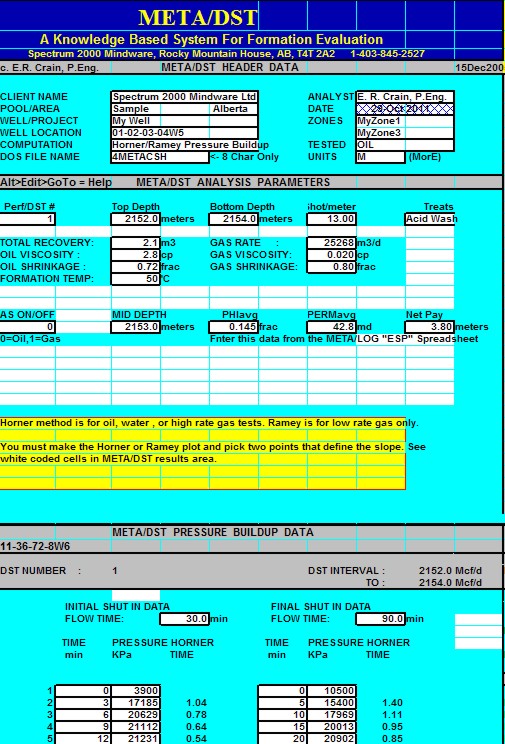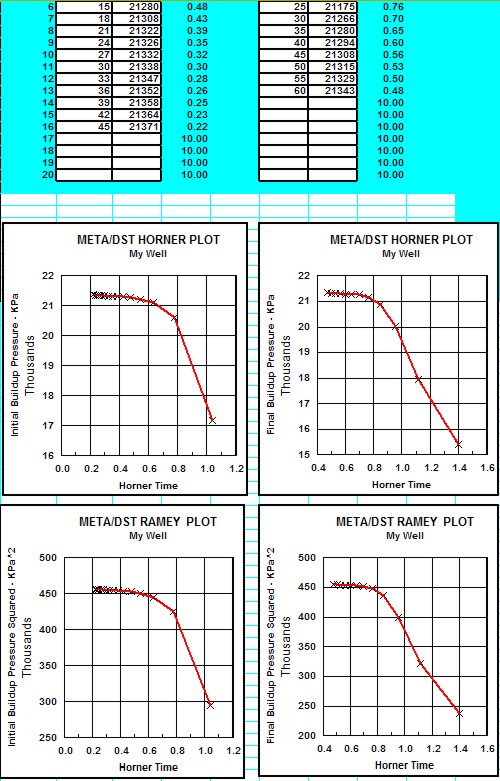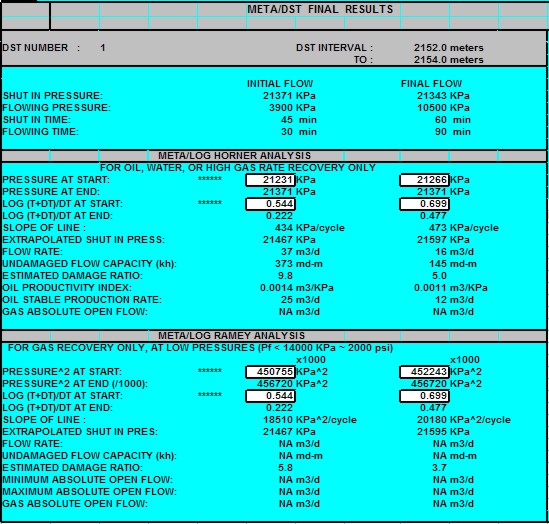|
The Horner method is used for oil, water, or high
pressure gas production. The Ramey method is used for low
pressure gas wells. A
spreadsheet called META/DST is available on the Downloads tab at
www.spec2000.net that makes the work relatively painless.
The Horner plot is a crossplot of buildup (or drawdown) pressure (Pi) on the Y axis versus a dimensionless time coefficient (HTi), usually called Horner Time, on a logarithmic X axis. A typical Horner plot is given below..
STEP 1: Calculate Horner time For Initial or Preflow portion of test: 1: HTi = Log ((IFT + DTi) / DTi)
For Final flow portion of test: 2: HTi = Log (((IFT + FFT) + DTi) / DTi)
Where: HTi = Horner time at point (unitless) DTi = Time since initial or final shut in for point (min) Pi = Initial or final flowing pressure (psi or KPa) IFT = Initial flowing time (min) FFT = Final flowing time (min)
Plot graph of Horner Time vs Shut-in Pressure as shown below.
3: DSTslope = ABS (SIPend - SIPstart) / (HTend - HTstart)
Where: "start" represents start of straight line portion of Horner plot "end" represents end of straight line portion of Horner plot
Calculate extrapolated shut in pressure: 4: SIPextr = SIPend + DSTslope * HTend
5: Qoi = IFP / FFP * DSTrec / IFT * 1440 6: Qgi = INITL DST gas rate 7: Qof = (1 - IFP / FFP) * DSTrec / (IFT + FFT) * 1440 8: Qgf = FINAL DST gas rate
STEP 4: Calculate flow capacity 9: Khoil = KQ1 * Qo * 1/Bo * VISO / DSTslope 10. Khgas = KQ2 * Qg * Zg * VISG * KQ3 * (FT + KT2) / DSTslope /(SIPextr + IFP)
Where: KQ1 = 162.6 for English units KQ1 = 2149 for Metric units KQ2 = 162.6 for English units KQ2 = 2.149 for Metric units KQ3 = 4.5 for English units KQ3 = 175.9 for Metric units KT2 = 460 'F for English units KT2 = 273 'C for Metric units
NOTE: This can be done for each buildup or drawdown period. Qo is in bbl/day or m3/day; Qg is in mcf/day or m3/day. Pressure buildups on Repeat Formation Tester (RFT) can also be analyzed with this method.
STEP 5: Calculate productivity data 11: Dratio = (SIPextr - IFP) / DSTslope / (log (IFT) + 2.65) 12: Dratio = (SIPextr - FFP) / DSTslope / (log (IFT + FFT) + 2.65) 13: PIo = KQ4 * Khoil / 1/Bo / VISO / (ln (10000) - 0.75 + 7 * (Dratio - 1))
Where: KQ4 = 0.00708 for English units KQ4 = 53560 for Metric units
14: AOFo = PIo * (SIPextr - IFP) 15: AOFg = Khgas*(SIPextr+KP2)^2)/(KQ5*(FT+KT2)*Zg*VISG)/(ln(10000)-0.75+7*(Dratio-1))
Where: KQ5 = 1424 for English units KQ5 = 1.309 for Metric units KP2 = 14.7 psi for English units KP2 = 101 KPa for Metric units KT2 = 460 'F for English units KT2 = 273 'C for Metric units
NOTE: AOFo is in bbl/day or m3/day; AOFg is in mcf/day or m3/day.
The Ramey plot is a crossplot of buildup (or drawdown) pressure squared (Pi^2) on the Y axis versus a dimensionless Horner Time, on a logarithmic X axis. The analysis arithmetic for SIP and Dratio are identical to that for the Horner method, except that pressure squared is substituted where ever pressure occurs in the equations. Also, the KHoil and AOFoil equations are not used. A typical Ramey plot is given below. 1: Khgas = KQ6 * Qg * Zg * VISG * (FT + KT2) / DSTslope
Where: KQ6 = 1637 for English units KQ6 = 1.508 for Metric units KT2 = 460 'F for English units KT2 = 273 'C for Metric units
2: AOFmin = Qg * SIPextr / ((SIPextr ^ 2 - IFP ^ 2) ^ 0.5) 3: AOFmax = Qg * SIPextr ^ 2 / (SIPextr ^ 2 - IFP ^ 2) 4: AOFg = Khgas*((SIPextr+KP2)^2)/(KD5*(FT+KT1)*Zg*VISG)/(ln(10000)-0.75+7*(Dratio-1))
Where: KD5 = 1424 for English units KD5 = 1.309 for Metric units KP2 = 14.7 psi for English units KP2 = 101 KPa for Metric units KT1 = 460 'F for English units KT1 = 273 'C for Metric units
NOTE: AOFg is in mcf/day or m3/day.
· Use only for stabilized buildup.
· Use to calibrate logs only if zone is not fractured, has not been stimulated, and exceeds 160 acres in size.
· The Horner method is used for oil, water, or high pressure gas production.
· The Ramey method is used for low pressure gas wells.
· The flow capacity calculated from the equations shown above is for the damaged condition of the reservoir. The AOF result has the damage effect removed.
· To compare Kh from logs with Kh from DST, the Kh from DST should be corrected for damage by the same factor as used in the AOF equation.
· Results may not compare to log analysis for many
reasons, such as insufficient build up time, reservoir
boundaries, vertical barriers, fractures, and reservoir
in-homogeneity. In addition, the log analysis flow capacity must
be summed over the same interval as drained by the DST. DST quality control is crucial. The Horner and Ramey methods only apply to valid tests which exhibit no boundary effects. DO NOT attempt Horner or Ramey analysis on an inappropriate DST curve.
|
||
|
Page Views ---- Since 01 Jan 2015
Copyright 2023 by Accessible Petrophysics Ltd. CPH Logo, "CPH", "CPH Gold Member", "CPH Platinum Member", "Crain's Rules", "Meta/Log", "Computer-Ready-Math", "Petro/Fusion Scripts" are Trademarks of the Author |
||


|
||
| Site Navigation | PERMEABILITY PRESSURE BUILDUP TEST HORNER and RAMEY PLOTS | Quick Links |




